At first glance they seem not so very different, standing at opposite ends of a street (which changes names halfway up it!) south of the Liffey, both built from the solid pale grey stone that distinguishes many of Dublin's oldest buildings. The current incarnation of both buildings include features from the 11th and 12th centuries, although the main structure for each dates to the 14th. Both cost 5 euros to enter, have leaflets with numbered 'landmarks' around the church with written explanations, and feature a gift shop just inside the door, at the back of the church.
Below - St Patrick's and Christ Church cathedrals are at opposite ends of a row of tenements built by the Guinness family to help house Dublin's poor. St Pats is shown in the first image, 'downhill'. while Christ Church sits higher, overlooking everything, in the second shot below.
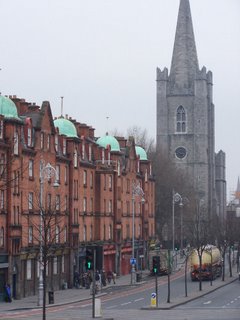
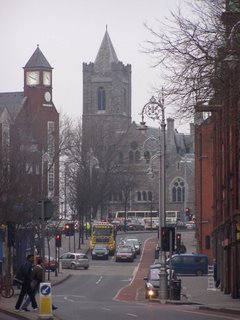 Here the similarities end.
Here the similarities end.Christ Church is, unashamedly, the church of Ireland's ruling classes - centuries of whom, you may recall, were English. Richard Strongbow is buried here, described as "the Cambro-Norman knight who captured Dublin in 1170". For centuries, Dublin's wealthy business folk sealed deals by swearing on Strongbow's grave. During Henry VII's reformation the church promptly and willingly abolished its abbey, embracing the new Church of England religion and winning Cathedral status. The church features statues of Charles I and II, a special pew for the monarch/head of state, featuring the Stuart royal arms, and a Civic Pew for the exclusive use of the mayor. The history of the church is dutifully recorded and presented as the kind of history lesson my parents grew up with - all dates and pomp and virtually no context.
Below - Christ Church Cathedral
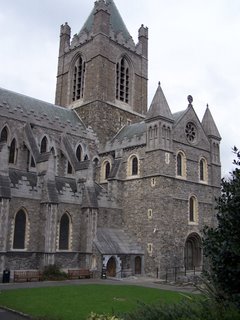

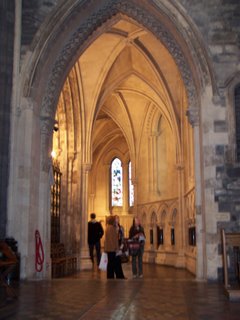
Above, the Lady Chapel at Christ Church
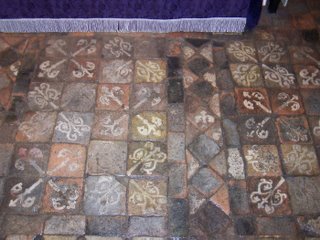 Original medieval floor in the Lady Chapel, Christ Church
Original medieval floor in the Lady Chapel, Christ Church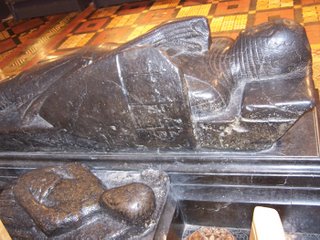 Strongbow's tomb - the original (remnants pictured at the bottom of the photo) was destroyed when part of the church collapsed in 1562) and its replacement features 14th C, not 12thC armour detail. Quite gorgeous nonetheless. Below - The remains of the original abbey - a 12th century romanesque doorway, and the ruins of the 13th century chapter house.
Strongbow's tomb - the original (remnants pictured at the bottom of the photo) was destroyed when part of the church collapsed in 1562) and its replacement features 14th C, not 12thC armour detail. Quite gorgeous nonetheless. Below - The remains of the original abbey - a 12th century romanesque doorway, and the ruins of the 13th century chapter house.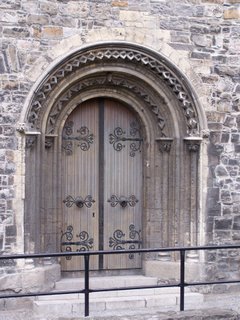

St Pats, by contrast, vividly recounts centuries of work on behalf of the most impoverished and disadvantaged people, peppered with subtle homilies for the virtues of faith, tolerance and respect for one's fellow man. The cathedral is said to have been built on the site of St Patrick's well, where the saint said his first mass in Dublin, and ancient celtic stones found on the site are respectfully displayed within.
Inside it hangs the Chapter Door, a relic of 1492 when, after years of feuding, the Earl of Ormond took refuge in the chapter house from his rival, the Earl of Kildare. Wishing to end hostilities, Kildare hacked a hole in the door and thrust his arm through the gap, as a sign of his goodwill. Ormond seized it and, with a handshake, the feud was over. It is said that the saying 'to chance one's arm' dates from this event.
This church is clearly proud of its standing as an ecumenical church. Hugenots, persecuted elsewhere, were sheltered here and worshipped in the Lady Chapel from 1666-1816. Jonathan Swift, author and social reformer, was dean of the Cathedral from 1713-45. During his time here he established Dublin's first hospital for the mentally ill, and received the Freedom of the City for opposing measures introduce a 'special' (read: devalued) currency that could only be spent locally, which many believed would have further entrenched the poverty of Dublin's poorest workers. The church is frank about the 'life long friendship' of Swift and his companion 'Stella' (Esther Johnson), who is buried beside him near the Cathedral's south wall.
Swift's contemporary, Archbishop Narcissus Marsh, founded Dublin's first public library, the Marsh Library, in 1701. It's located next door.
Below - the Lady Chapel at St Pats, which was set aside for Hugenot worship when their followers fled England in the 17th -19th centuries; the altar; Celtic tombstone found when the church was being built; the Chapter Door which gave rise to the saying 'to chance one's arm'; the tomb of Jonathan Swift- author, dean of St Pats, freeman of the City - and his companion 'Stella'.
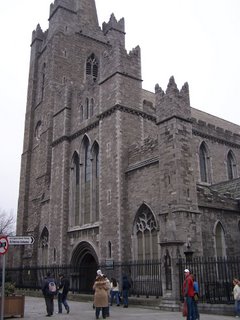
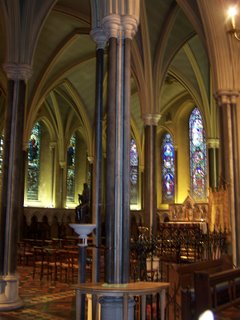
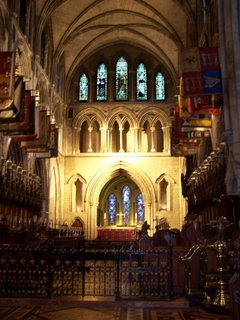
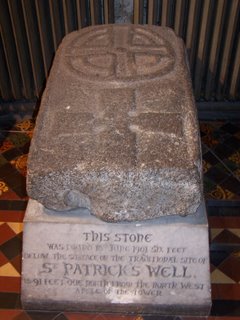
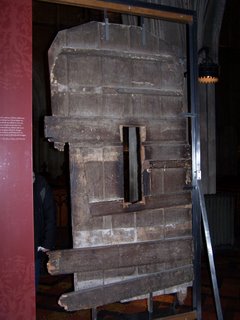
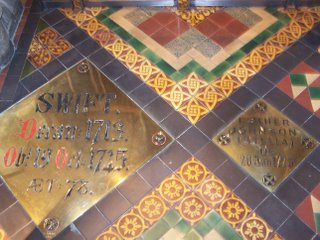
It seems now no accident that Christ Church - the cathedral of the english monarchs, sits atop the hill, towering over St Pats down the other end of the street, which. it claims "embodies the history and heritage of Irish people of all backgrounds from the earliest times to the present day". And, in true Irish fashion, St Pats tells its stories better, too.



No comments:
Post a Comment